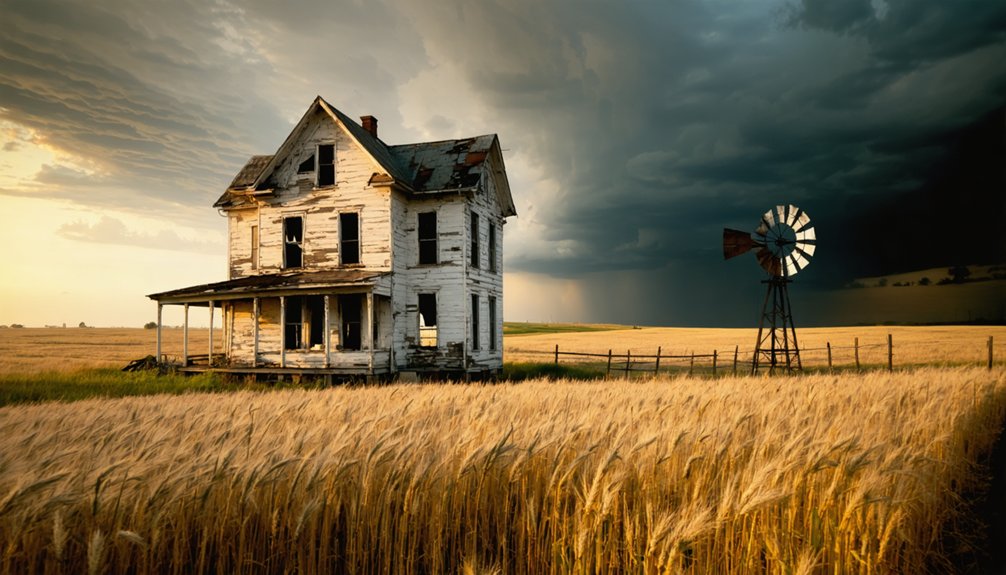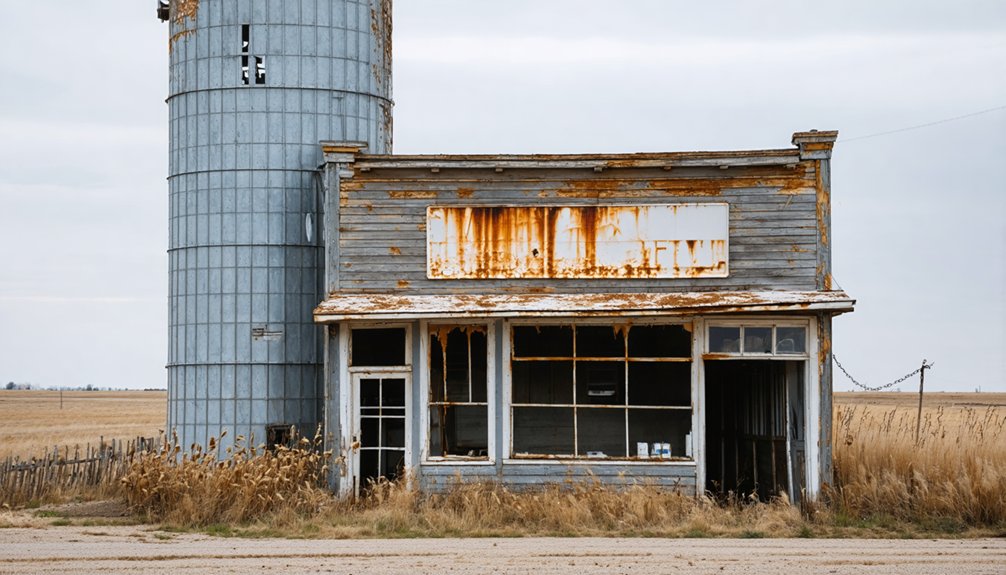Discovering abandoned homesteads across the Great Plains reveals America’s settlement struggles, with nearly half of homesteaders never completing their claims. You’ll find weathered structures that tell stories of inadequate 160-acre plots, harsh prairie conditions, and the devastating Dust Bowl that forced 2.5 million people to migrate. For meaningful exploration, seek permission from landowners, research BLM records, and photograph with wide-angle lenses to capture textural details. The prairie’s silent remnants await your respectful documentation.
Key Takeaways
- The Great Plains contains thousands of abandoned homesteads, with 45% of initial homesteaders never completing their claims due to harsh conditions.
- Architectural remnants reveal evolution from simple rectangular layouts to complex designs with features adapted for extreme prairie climate conditions.
- Essential research tools include the BLM’s General Land Office Records, federal tract books, and homestead case files from National Archives.
- Ethical exploration requires landowner permission, thorough documentation, and respect for historical sites’ integrity and legal boundaries.
- Photography techniques for capturing homestead ruins include wide-angle lenses, tripods, and composition emphasizing weathered textures and storytelling elements.
The Silent Testimony: Ghost Towns of Failed Homestead Communities

Across the vast expanses of the Great Plains, abandoned homesteads stand as silent sentinels to America’s failed agricultural ambitions. These ghostly echoes of settlement pepper the landscape—Kansas alone harbors thousands of ghost towns where hopeful pioneers once envisioned thriving communities.
You’re witnessing the physical remnants of staggering failure rates: approximately 45 percent of initial homesteaders never completed their claims, and only one-third ultimately secured land titles. The abandoned dreams these structures represent tell a deeper story of environmental mismatch—160-acre plots proved woefully inadequate in regions receiving insufficient rainfall for traditional farming. Many settlers lacked farming experience and were unprepared for the harsh realities of prairie agriculture. Wallace Stegner’s characterization of these settlers as wheat miners rather than true farmers accurately reflected their extractive relationship with the land.
Communities like Nicodemus and Dearfield represent rare survivors among countless settlements that have returned to grassland. Most “stickers” who persevered initially were eventually driven away by drought within a single generation, leaving only wind-swept foundations as testimony.
Weathered Remnants: Architectural Clues to Homesteader Life
Broken chimneys and weathered foundations across the Great Plains offer archaeologists and historians profound insights into homesteader life through their distinctive architectural remains.
When you examine these structures, you’ll notice the architectural evolution from simple rectangular layouts with thick sod or clay walls to more complex multi-room designs added as families grew.
The homesteads reveal pragmatic adaptations to harsh conditions—thermal mass walls insulating against temperature extremes, east-facing entrances avoiding prevailing winds, and steep roofs efficiently shedding precipitation.
Post-and-beam framing with local materials demonstrates resourcefulness amidst lumber scarcity. Unlike the indigenous architectural harmony, these structures often demonstrate incongruence with place through imported building traditions.
Most compelling is the homestead symbolism embedded within these weathered remnants. Central hearths represented family unity, while four-post systems connected settlers to natural elements.
These abandoned structures aren’t just ruins—they’re cultural artifacts preserving the ingenuity of those who sought independence on unforgiving plains.
This architectural approach differed significantly from indigenous earth lodge dwellings that were perfectly adapted to Plains climate with their circular designs and natural insulation.
Black Homesteading Heritage: Tracing Nicodemus and Dearfield’s Legacy
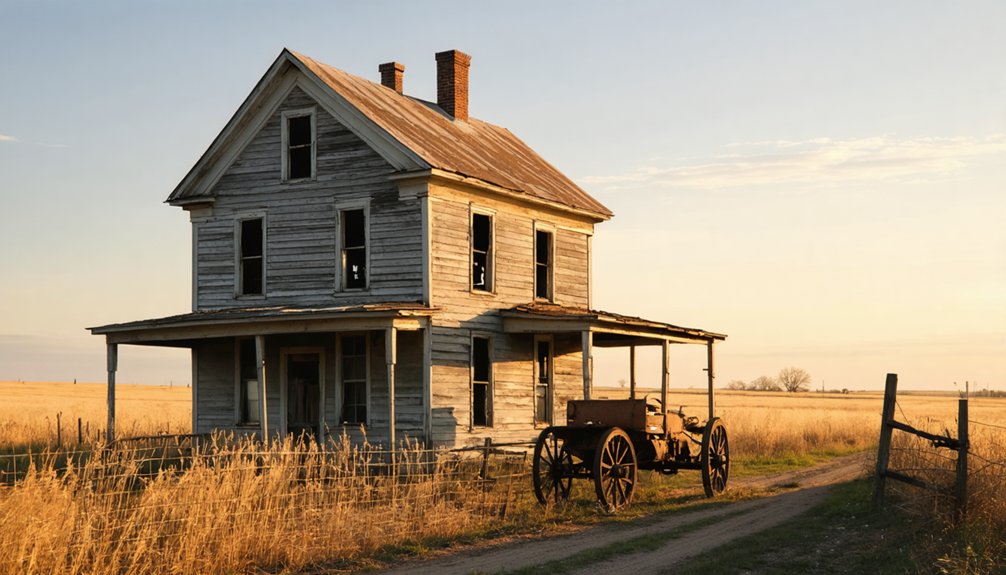
When you explore the Black homesteading legacy across the Great Plains, you’ll find vanishing communities like Nicodemus—preserved against the relentless dust that claimed other settlements—revealing a rich historical tapestry.
Your journey through these landscapes uncovers the architectural remnants of homesteader determination, where figures like Oscar Micheaux transformed their agricultural experiences into pioneering films documenting Black western life.
The conservation of these historic sites becomes increasingly urgent as physical structures deteriorate, taking with them the tangible evidence of African American westward migration following Reconstruction. Nicodemus eventually became a National Historic Site in 1996, recognized by Congress for its significance in African-American migration history. Each July, the town celebrates its heritage with an Emancipation/Homecoming Celebration that draws hundreds of descendants and former residents who keep the community’s stories alive.
Vanishing Prairie Communities
Among the vanishing prairie communities that once dotted America’s Great Plains, Nicodemus stands as a remarkable symbol of Black homesteading resilience and determination. Founded in 1877 as part of the post-Civil War Black migration westward, this Kansas settlement represented freedom and opportunity for formerly enslaved people fleeing the South’s oppressive Jim Crow laws.
At its peak, Nicodemus thrived with over 600 residents and numerous Black-owned businesses. However, being bypassed by the railroad dealt a devastating economic blow. The Nicodemus townspeople’s efforts to attract the Missouri Pacific Railroad failed when they raised $16,000 in bonds that went unused after the company withdrew its plans. The harsh realities of frontier life—inadequate shelter, limited resources, and agricultural challenges—forced many to abandon their hard-earned homesteads. In the earliest settlement days, many residents survived by living in primitive dugouts while receiving crucial assistance from Native American tribes.
Today, fewer than 25 people remain, yet Nicodemus’s legacy endures through preservation efforts and annual homecoming celebrations that honor those who risked everything for self-determination on the unforgiving prairie.
Oscar Micheaux’s Pioneering Films
Rising from the harsh South Dakota plains to become America’s first major Black filmmaker, Oscar Micheaux transformed his homesteading experiences into groundbreaking cinema that documented an overlooked chapter of American history.
When you visit these abandoned homesteads today, you’re walking the same ground where Micheaux crafted “The Homesteader” (1919), the first feature-length film with an all-Black cast and crew. His cinematic representation challenged Hollywood’s racist stereotypes by portraying Black professionals and addressing racial injustice head-on.
Micheaux’s impact extended beyond entertainment—his films preserved the legacy of Black pioneers who built communities like Nicodemus and Dearfield despite overwhelming discrimination. Micheaux initially published “The Conquest” in 1913, which was loosely based on his experiences as a homesteader in South Dakota. The film explored complex interracial relationships, including the forbidden love between Jean Baptiste and Agnes, whose biracial heritage remained hidden until the story’s conclusion.
Though many of his films are lost, including “The Homesteader,” Micheaux’s work continues to illuminate the forgotten history of Black homesteaders who claimed their freedom on the Great Plains frontier.
Preservation Against Dust
Though nearly erased by the relentless prairie winds, the remaining structures of Nicodemus stand as monuments to Black pioneers who established thriving communities amid the harsh Great Plains landscape.
Their preservation against dust erosion represents an essential connection to America’s Black homesteading heritage. The National Historic Site designation has enabled significant homestead restoration efforts while maintaining the authentic character of this remarkable settlement.
- Visit the dugouts and sod house foundations, where former slaves first sheltered from harsh elements while building their dream of freedom.
- Witness the town’s core 160 acres, now protected through conservation initiatives that shield these historic structures from the persistent dust that once threatened to bury them completely.
- Participate in the annual Emancipation/Homecoming Celebration, connecting with descendants who maintain their ancestors’ legacy of self-determination.
Dust Bowl Exodus: Abandoned Farms as Ecological Warning Signs
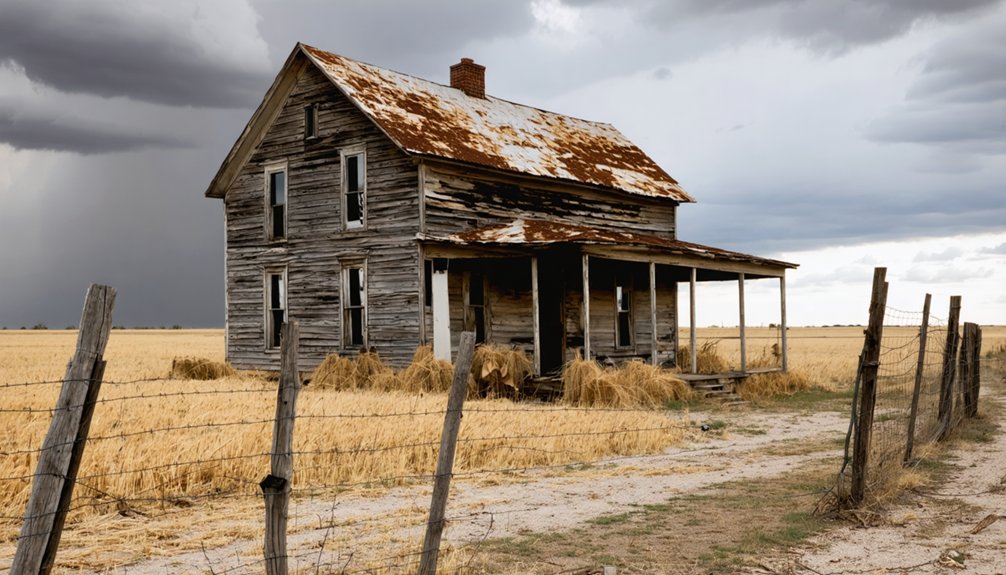
When the Great Plains transformed into the infamous Dust Bowl during the 1930s, abandoned homesteads emerged as stark ecological warning signs that we’ve largely failed to heed.
These silent ruins tell a devastating story of abandonment causes rooted in misguided agricultural practices—deep plowing that destroyed native grasses and farming techniques unsuited for semi-arid conditions.
The ecological consequences were catastrophic. Nearly 750,000 family farms vanished as 2.5 million people fled, with half a million “Okies” migrating westward seeking survival.
You can still witness the aftermath of this exodus in skeletal homesteads scattered across the landscape. Each abandoned property became an erosion source, spreading destruction to neighboring lands through dust storms.
These forgotten farms stand as permanent monuments to humanity’s hubris—reminders that when you ignore natural limits, nature will ultimately force your hand.
Photography Tips for Capturing Homestead Ruins
Photographers seeking to document Great Plains homestead ruins face unique challenges that demand both technical skill and artistic sensitivity.
Select essential gear including wide-angle lenses for capturing expansive interiors and a sturdy tripod for the often dim lighting conditions. Your composition techniques should emphasize foreground elements that tell the homestead’s story while utilizing apertures around f/8-f/9 for maximum sharpness.
Lighting strategies require careful attention—use graduated ND filters to balance bright skies against darker ruins, and consider long exposures to capture dramatic cloud movements over abandoned structures.
For evocative imagery:
- Frame shots highlighting textural contrasts between human-made structures and reclaiming nature
- Capture close-ups of weathered details that speak to bygone eras
- Experiment with black and white conversions to emphasize the stark, timeless quality of abandonment
The Legal Paper Trail: Finding Records of Abandoned Claims
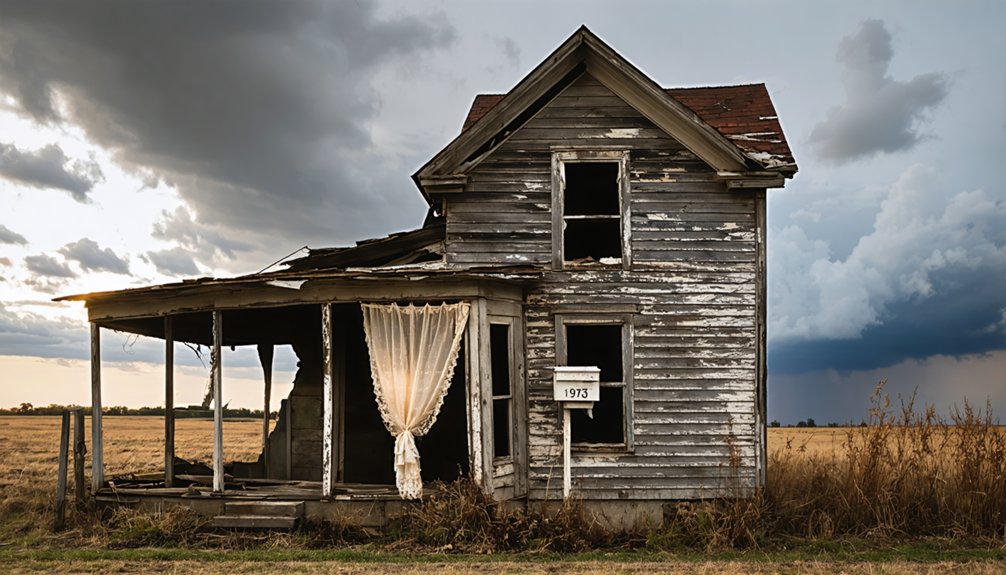
The legal paper trail of abandoned homesteads presents researchers with three primary pathways for discovering these forgotten claims.
First, explore the Bureau of Land Management’s General Land Office Records website for initial patent information, though you’ll need to dig deeper for abandoned claims that never reached patent status.
Second, investigate federal tract books organized by township and range rather than by surname. These volumes contain vital legal descriptions that link land parcels to specific homesteaders who filed claims but never completed them.
Third, request homestead case files from the National Archives, where applications and testimony from unfinished claims are preserved. You’ll need the homesteader’s name, state, and approximate entry date.
For pre-1908 records, a legal description is essential, while post-1908 claim records are more accessible through name indices.
Respectful Exploration: Ethics of Visiting Historical Homestead Sites
When visiting historical homestead sites, you must first secure proper permission from landowners or relevant authorities, as many sites exist on private property or protected lands.
You’ll enhance preservation efforts by thoroughly documenting your observations through notes and photographs while maintaining the site’s historical integrity.
Don’t remove artifacts, alter structures, or disturb the surrounding environment during your visit, as these actions undermine conservation efforts and may violate preservation laws.
Obtain Permission First
Respecting legal boundaries and ethical considerations must precede any exploration of abandoned homesteads across the Great Plains. Most sites lie on private property, making landowner permission absolutely vital.
Research land ownership through county records before approaching landowners with clear, respectful permission protocols. When requesting access, explain your specific interest, intended duration, and commitment to leaving no trace.
- The thrill of discovering a forgotten homestead, its weathered boards telling stories of pioneer struggles, becomes infinitely more meaningful when you’ve honored the landowner’s stewardship
- Each permission granted creates a bridge between past and present, connecting you to both history and today’s rural communities
- Standing lawfully on that creaking porch, you’ll feel a freedom that trespassing can never provide—the freedom of integrity
Proper landowner etiquette guarantees both legal protection and preservation of these irreplaceable historical treasures.
Document, Don’t Disturb
Four essential principles govern ethical exploration of abandoned homesteads: document meticulously, disturb nothing, leave no trace, and share respectfully.
When you discover weathered structures or scattered artifacts, resist the urge to rearrange or collect them—federal laws like ARPA protect these historical treasures. Instead, employ proper documenting techniques: photograph items in their original context, record GPS coordinates, and maintain detailed notes about site conditions. These practices preserve the site’s authenticity while contributing valuable historical data.
Artifact preservation begins with non-interference. Even moving a rusted implement for a better photo disrupts the archaeological record and diminishes the site’s integrity. Your footprints should be temporary, but your documentation can last generations.
Seasonal Changes: When to Best Experience Great Plains Abandoned Properties
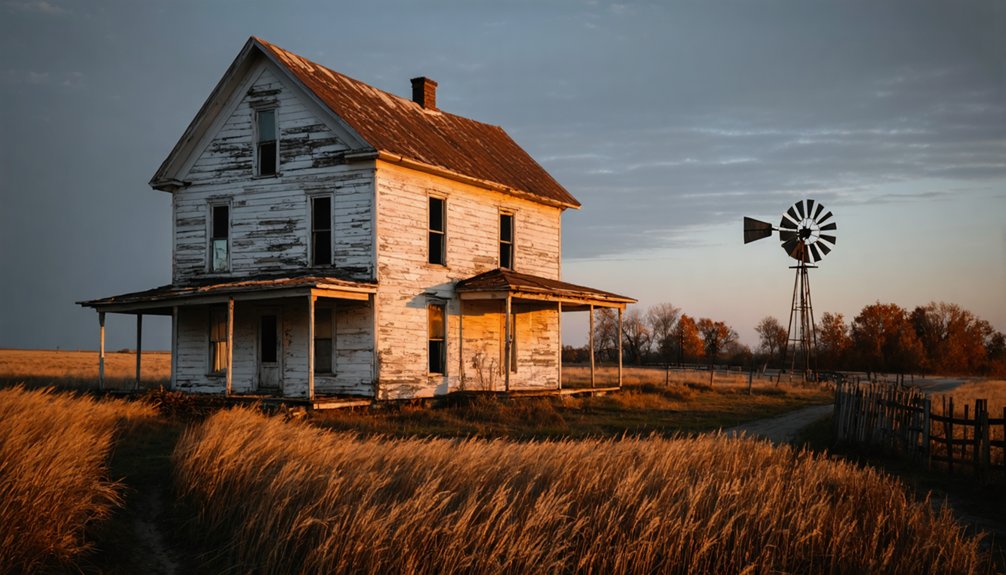
The Great Plains region offers distinctly different experiences of its abandoned homesteads throughout the year, with each season revealing unique aspects of these forsaken properties.
Each season unveils the abandoned homesteads of the Great Plains differently, revealing new facets of these forgotten places.
For ideal seasonal exploration, consider visiting in late fall (October-November) when the perfect balance of clear visibility, mild temperatures, and minimal vegetation creates prime conditions.
Winter exposes hidden structural elements as leafless trees and dormant grasses reveal foundations and architectural details otherwise concealed.
Spring’s volatile weather patterns require careful weather considerations to avoid dangerous storms and impassable muddy roads.
- Witness the haunting silhouettes of abandoned farmhouses against autumn’s golden prairie grasses
- Experience the profound silence of winter’s snow-blanketed homesteads frozen in time
- Feel the poignant contrast between nature’s renewal and human departure during spring’s verdant growth
Frequently Asked Questions
Were Homestead Claims Contested by Native American Tribes?
Yes, tribes vehemently contested homestead claims, fighting for land sovereignty while facing devastating cultural displacement. Your exploration reveals America’s complex history of territorial seizure and indigenous resistance against settler expansion.
What Items of Value Are Commonly Found in Abandoned Homesteads?
Time’s buried treasures await your discovery. You’ll find valuable antiques like glass bottles, metal tools, jewelry, and historical artifacts including buttons and ceramics—all windows into our shared past that deserve preservation.
How Did Homesteader Suicides Compare to National Rates?
You’ll find homesteader suicides exceeded national rates by 20-30%, driven by isolation and economic strain. Their mental health struggles, within historical context, were exacerbated by limited resources and the pervasive “cowboy up” mentality.
Can Descendants Reclaim Abandoned Homestead Properties Today?
Like Odysseus returning to Ithaca, you can reclaim abandoned ancestral homesteads, but you’ll face significant legal challenges establishing property rights through heirs’ property laws, affidavits, and possible partition actions.
Did Government Programs Compensate Failed Homesteaders During the Dust Bowl?
Yes, you’d receive partial compensation through New Deal programs during the Dust Bowl. These relief efforts mitigated the economic impact but rarely restored what you’d lost as a failed homesteader.
References
- https://blogs.loc.gov/maps/2023/12/climate-migrants-of-the-1930s-dust-bowl/
- https://www.nps.gov/articles/african-american-homesteaders-in-the-great-plains.htm
- https://storymaps.arcgis.com/stories/2ea771a64e2a4f658c0a5a0d9c34307d
- https://en.wikipedia.org/wiki/Homestead_Acts
- https://dsl.richmond.edu/panorama/homesteading/map/text/introduction
- https://onlinelibrary.wiley.com/doi/full/10.1002/aepp.13401
- https://news.prairiepublic.org/podcast/plains-folk/2024-11-16/great-plains-homesteaders
- https://www.huduser.gov/portal/pdredge/pdr-edge-housingat250-article-091125.html
- https://unpblog.com/2024/10/21/excerpt-great-plains-homesteaders/
- https://www.thenation.com/article/archive/unsettled-great-plains/
